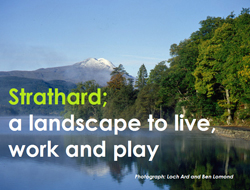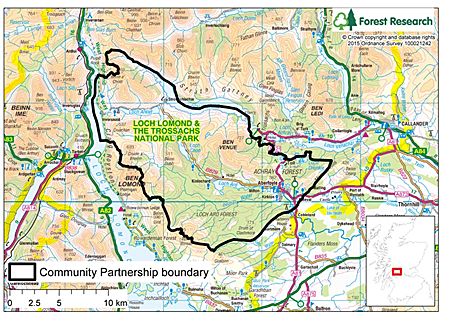Summary
Summary
 This project aims to improve land and water management decisions in Strathard, a rural area of western Scotland located in the Loch Lomond and Trossachs National Park. In order to develop more sustainable and resilient land and water management plans, an ecosystems approach is being used. In its most basic form, an ecosystems approach is the acknowledgement that natural and human systems are interconnected. Nature provides many goods and services, from the food that we eat to natural flood management. By improving the way the land is managed we can increase the benefits we get from nature now and into the future.
This project aims to improve land and water management decisions in Strathard, a rural area of western Scotland located in the Loch Lomond and Trossachs National Park. In order to develop more sustainable and resilient land and water management plans, an ecosystems approach is being used. In its most basic form, an ecosystems approach is the acknowledgement that natural and human systems are interconnected. Nature provides many goods and services, from the food that we eat to natural flood management. By improving the way the land is managed we can increase the benefits we get from nature now and into the future.
In order to improve land management decisions an assessment of what benefits we currently gain from our surroundings was needed. Led by SEPA and working with a number of project partners this project aims to achieve this using a range of techniques to gather information on ecosystems and their services. An important part of the ecosystems approach is taking into account the views of different stakeholder groups and local communities. We did this using surveys, participatory GIS (geographic information systems) mapping, and community events.
The information gathered from the communities and stakeholders are being integrated with outputs from more detailed modelling of selected ecosystem services, using approaches developed by Forest Research’s Land Use and Ecosystem Services and Forest Hydrology groups.
The results are being used to evaluate and compare the effects of different land and water management actions. By considering the wider impacts and benefits of these actions, improved management decisions can be made which address the needs of the local communities whilst promoting sustainable use of the land.

Research objectives
- Create strong working relationships and dialogue with local communities : The project aims to foster closer working relationships and partnerships between agencies, visitors, landowners, local businesses and the community in a joint approach in order to help us identify and trial land management and natural flood management solutions.
- Carry out a standardised, transferable assessment : This project will assess ecosystem services using standardised approaches that can be used in other study areas, as recommended by the Millennium Ecosystem Assessment (MEA). We’re using the Common International Classification of Ecosystem Services (CICES) and European Nature Information System (EUNIS) habitat classification, both of which are international frameworks.
- Collect data on ecosystem services: We will collect data on provisioning, regulating and cultural ecosystem services that are currently provided in Strathard. The project aims to take a broad and shallow approach in addition to more focused assessment in key areas. This will be achieved through a multi-stranded assessment. A range of techniques have been used to capture information on all CICES services while certain key services are being assessed using models and indicators which provide a more in-depth evaluation.
- Collate and analyse data on service provision and ecosystem condition: The ability of an ecosystem to provide a service depends on both the type of ecosystem and its condition. Therefore, in addition to assessing the type of services different habitats provide we will evaluate the extent to which these services are provided and how the delivery of services might be affected by condition of the ecosystem.
- Hydrology assessments of water quality and flow: A key issue in the area is flooding and our hydrology team, who helped lead the ‘Slow the Flow’ project in Pickering, is providing information to help understand the potential use of Natural Flood Management measures, such as woody debris dams.
- Combine the ecosystem service assessment with hydrological study: The results of both the ecosystem assessment and hydrological study will be used to identify locations in the study area suitable for Natural Flood Management based on both the physical characteristics and the current value of the location based on the services it provides and importance to the local community. The intention is to trial land and natural flood management measures in the Duchray catchment from 2017.
- Provide guidance on future management options: The results will be used to direct other land and water management in the area.For example, forest management and design plans in the study area will be able to better take into account ecosystem service provision, which will contribute to design plans which have multiple economic, environmental and social benefits.
Results so far
Create strong working relationships and dialogue with local communities:
During the first phase of this project we developed methods to capture relevant information from local people, and as part of this created two online surveys, one for the local community and one for visitors. These were used in conjunction with other public engagement at a wide range of community engagement events run by the Strathard project partnership, including:
- The “Strathard Project Community Launch Event” in Kinlochard Village Hall, February 2016. Various engaging and interactive stalls provided attendees with an opportunity to understand more about the aims of the project and to provide a chance to help identify particular issues and opportunities that they would like to see addressed Social Media feeds
- A film was developed to introduce the project, which included footage of members of the community discussing the benefits and challenges of Strathard’s landscape. This was shown at the project launch and is available as a YouTube video.
- A Twitter account was set up to provide project updates.
- An online and printed survey to gather information from locals and visitors on how they value the different ecosystem types found within Strathard.
- An interactive ‘MapMe’ mapping survey that asked people to ‘spray’ areas on a scalable map of recreational or aesthetic value and areas where they would like to see improvements.
- In depth interviews with local people on the benefits and challenges of the Strathard landscape.
- A Community Partnership project webpage providing some background to the project, answers to frequently asked questions, and a point of contact.
- A community e-newsletter provides regular updates on the project and associated events.
- Guided Forest Tours were run by Forest Enterprise Scotland in August 2016 to provide local people with a chance to find out more about tree felling, thinning, replanting, the hydro-site and the future of native woodland sites in Strathard.
- A community mapping workshop at Kinlochard Village Hall, September 2016 to provide information on the technical methods we used to gather and analyse the data gathered.
- An online ‘StoryMap’ was developed to explain the initial results of the project in an accessible format.
- We have also presented this project at a range of international conferences and workshops, including the ESCom 2016 conference, the European Ecosystem Services conference 2016 in Antwerp, an ialeUK student workshop on PPGIS, and the ialeUK 2016 conference on landscape characterisation.
Collect data on ecosystem services:
During the first phase of this project we developed methods to collect and compile a wide range of environmental and social data to map ecosystem services. Habitats were mapped using the EUNIS habitat classification system and the likely capacity of these habitats to provide each ecosystem service was quantified and mapped. These data were collected via online surveys, community events, interviews and expert opinion. The Land Use and Ecosystem Services Science Group also provided more detailed, site specific modelled data for some ecosystem services.
Ecosystem condition:
An ecosystem condition assessment was carried out using a variety of spatial analysis tools and models combined with the best available spatial data for Strathard. A number of patch and landscape scale indicators of habitat condition were developed and mapped for priority habitats in Strathard. The results can be used to spatially prioritise actions and resources in an effort to strategically improve habitat condition across the landscape.
- Mire
- Heath
- Grassland
- Water bodies
- Woodland
Hydrology assessments of water quality and flow:
Through hydrological modelling in GIS we identified suitable locations for natural flood management features across the site, including a site within the Duchary catchment where the project partnership hope to provide a woody debris dam demonstration and monitoring site (subject to funding).
Opportunity maps
We have used the collated data and modelled outputs in a GIS to develop opportunity maps to help target a range of priority management actions:
- Natural flood management
- Riparian invasive and browsing mammal management
- Blanket bog and other priority habitat restoration
- Woodland planting
- New wetland features to better connect water vole habitats
Status
The first phase of this project started in October 2015. Based on the information collected to date, funding opportunities and available resources, the partnership are prioritising actions and developing action plans to take forward during 2017-2019. As part of this, Forest Research’s Huw Thomas is now working with the Cowal and Trossachs Forest District to help lead a natural flood management strategy and monitoring programme, which will include a demonstration leaky woody dam in the Duchray catchment in 2018.
Contact
Funders and partners
This project is co-funded by Scottish Environmental Protection Agency (SEPA), Forest Enterprise Scotland, Loch Lomond and the Trossachs National Park Authority (LLTNPA), Scottish Natural Heritage (SNH), with support from partnership agencies Stirling Council and the Community Partnership.
SEPA initiated this project following a request from the Scottish Government’s Rural Affairs, Food and the Environment (RAFE) Delivery Board to improve joint working between public bodies. The Duchray catchment in Strathard was identified as a suitable trial location for developing a strategic level ecosystems service assessment to support sustainable decision-making in land use and water management. The role of Forest Research is to conduct an ecosystem service assessment and identify potential suitable locations for action plans through data collection and analysis.
Forestry Commission policy
The Forestry Commission implements Government policy on both woodland biodiversity and sustainability
